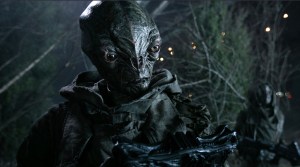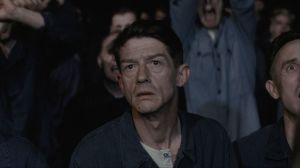“This thing that’s coming — it’s known as the collector of worlds, but its true name is Brainiac.”
Videos by ComicBook.com
That’s what Adam Strange told Seg-El, the grandfather of Superman, in last week’s pilot to Krypton, SYFY’s new DC Comics series that pits Strange, Seg, and a handful of powerless, rankless Kryptonians against the power of one of DC’s most intimidating villains.
And, to make matters worse, they’re all living in Kandor City, a place that history dictates Brainiac will eventually do some serious damage to.
So who is Brainiac? There are a lot of answers: in his original iteration, he was an alien who wore tights, had super-strength, and bottled alien cities to learn their wisdom in a lab. Later, he would be built as a cyborg intelligence that flew in a giant skullship.
Later still, Brainiac would be a Coluan alien infiltrating the mind of a circus performer, and then ultimately a cybernetic nightmare creature that had used all of these previous iterations as emissaries.
So, of all those strange and varied forms, which are the stories that best represent Brainiac?
You can check out our list below.
Action Comics #242

Yes, the Bottle City of Kandor was there from the beginning.
In “Super-Duel in Space,” Superman first met the green-skinned, pink-tights-wearing alien calling himself Brainiac and the two did not get along.
In this version, Brainiac stole cities so that he can repopulate his lifeless homeworld — something that would be rarely used once he became a collector of information, although it certainly was used much later (we’ll get to that). Superman battled him to free the worlds, but was unable to figure out just what to do with Kandor, since he could not exactly restore it to the destroyed Krypton.
He kept the city bottled in the Fortress of Solitude, ostensibly until he could figure out a way to fix its problem, and there it remained for most of the rest of Superman’s publishing history.
Whatever Happened to the Man of Tomorrow?

Likely in the running for the most beloved comic book story ever to feature Brainiac, “Whatever Happened to the Man of Tomorrow?” was a story by a pre-Watchmen Alan Moore and Dave Gibbons, who teamed up to tell the last story of the pre-Crisis on Infinite Earths Superman.
His three most formidable foes — Brainiac, Lex Luthor, and Mr. Mxyzptlk — all came together to battle Superman, whose “death” was the foregone conclusion of the story, which was being told by Lois Lane to a reporter years after the last documented appearance of the Man of Steel.
Brainiac and Luthor have often had a somewhat fraught relationship, and this story was the ultimate example of that, as Lex found himself subjugated to Brainiac and used as a vessel for the villain as he made his final play for Superman and the Fortress of Solitude.
The Brainiac Trilogy

In the post-Crisis on Infinite Earths era, Brainiac had been a circus performer named Milton Fine, whose mental powers turned out to be less an act and more alien intervention.
The alien aspects of Brainiac began to really play into the story here, as he reveals to Luthor (with whom he has been working) that he was never really Milton Fine, but rather had been a genius on Colu whose body was vaporized by the computer tyrants on the world for failure to live up to their standards. His mind survived and found refuge in Fine’s body.
Ultimately, he would break off his partnership with Luthor and try to kill both Superman and Luthor — and then once defeated, he created a giant skullship somewhat reminiscent of one he had used in the late Silver and Bronze ages and flew off into space, vowing to return.
Panic in the Sky

Following the events of “The Brainiac Trilogy,” this is the first major “alien invasion”-style story from the post-Crisis on Infinite Earths version of Brainiac.
“Panic in the Sky!” involves a world where there’s no Justice League (it had been disbanded following the events of “Breakdowns”), so Superman recruits a number of heroes to go meet Brainiac in space, battling him on his own turf (in this case Warworld) before he can reach Earth and start breaking stuff. Yeah, there’s a little bit of chaos in Metropolis, but nothing that Gangbuster, Guardian and Aquaman can’t handle.
Most of the big fighting happens on Warworld and Brainiac is turned back without significant casualties…but that isn’t because the battles aren’t sufficiently epic.
One of the earliest post-Crisis big event-scale stories, “Panic in the Sky” put Superman in charge of the League — a job he would keep right up until his death at the hands of Doomsday.
Superman: The Animated Series

The animated series took Brainiac in a very different direction and it was actually kind of refreshing.
Brainiac was the planetary-wide supercomputer of Krypton until it left shortly before the planet’s destruction. Afterwards, Brainiac traveled the galaxy in pursuit of knowledge and destroyed the sources of the knowledge to increase its value and sought to apply this to the entire universe to complete what it perceived as its function and purpose, making it a nemesis of Superman.
There are elements of Brainiac’s role in the animated series that seem to draw inspiration from The Eradicator, a device created by Superman’s ancestors and explored during the post-Crisis on Infinite Earths continuity, but the earliest episodes of the animated series, which center on Brainiac’s role in the end of Krypton’s life and the start of Superman’s history, are some of the best episodes of the show, and one of the best representations of the character ever onscreen.
The Doomsday Wars

In Superman: The Doomsday Wars, Brainiac finds himself a new host…one that actually stands a chance when Superman comes gunning for him: Doomsday.
It was not immediately presented as a Brainiac story, but rather as a Doomsday one. The mindless, rampaging brute that beat Superman to death suddenly reappears…with a brain, and mental defenses.
How does Superman eventually defeat Brainiac now that he has an indestructible body and has run roughshod over the Justice League?
Well, he doesn’t. Doomsday is a creature that continuously evolves to protect himself from external threats, and eventually it is his own ability to expel Brainiac’s consciousness that saves the day.
This one is included partially becuase it’s a fun romp full of spectacular visuals and cool ideas…and partially becuase it is absolutely plausible that we will see Brainiac trying to take over a Doomsday monster (remember, it’s Kryptonian and ancient) on Krypton.
Justice

An out-of-continuity story, Alex Ross and Jim Kreuger’s Justice is one of the best-loved DC stories in recent decades, and Brainiac is — as you can see in the image above — front and center.
Its story involves the superhero team known as the Justice League of America confronting the supervillain team the Legion of Doom, with the villains taking on a quasi-heroic role and battling the heroes to avoid a future in which they believe the Earth to be doomed.
The plot is complex and involves nearly every major DC superhero and villain from the “Super Friends” era, but suffice it to say, Brainiac has a major (and badass) part to play in the drama, and Justice remains a worthwhile addition to Ross’s fan-favorite resume.
Brainiac

From Geoff Johns and Gary Frank, the “Brainiac” storyline that served as the basis for the animated movie Superman Unbound seems to be the story most directly influencing at least the look of Krypton.
In the story, it is revealed that Superman has never fought the real Brainiac, as all earlier encounters Superman had with Brainiac were with one of his probes. It is also revealed that Supergirl was on Krypton when Kandor was stolen, and because of this is terrified of Brainiac.
The eventual result was not only a redefining of the character of Brainiac into something more sinister and terrifying than ever before, but the death of Jonathan Kent, Superman’s adoptive father. It changed Superman from the time of its telling in 2008 until that version of the hero was rebooted in 2011, and elements of the story have resonated even through the reboot.
Convergence

This much-maligned storyline might not be DC’s best-ever crossover, but it was a fun concept and it did, after all, revolve entirely around Brainiac.
After the “real” Brainiac was finally defeated by Superman, it was revealed that his homeworld — Telos — had been where he was taking bottled cities collected just before the dying moments of doomed realities. He was attempting to create a kind of patchwork world that he could study, but he had more cities than he could use and a representative he left behind (an artificial life form also named Telos) decided to allow the various cities and realities to fight for the right to survive on the surface of the world in the absence of someone to care for them all.
Brainiac himself would return, larger and more terrifying than ever, and would ultimately marshal a multiverse army to face off against an opposing army led by Superman and the heroes of the DC Universe. Ultimately, the bottled cities would be restored to their proper timelines and homeworlds, while Telos itself would become inhabited by the residents of the then-recently-destroyed Earth-2. Telos the character briefly got his own comic, in which he went on a kind of quest to learn about his own past and reclaim a sense of individuality Brainiac had stolen from him.








